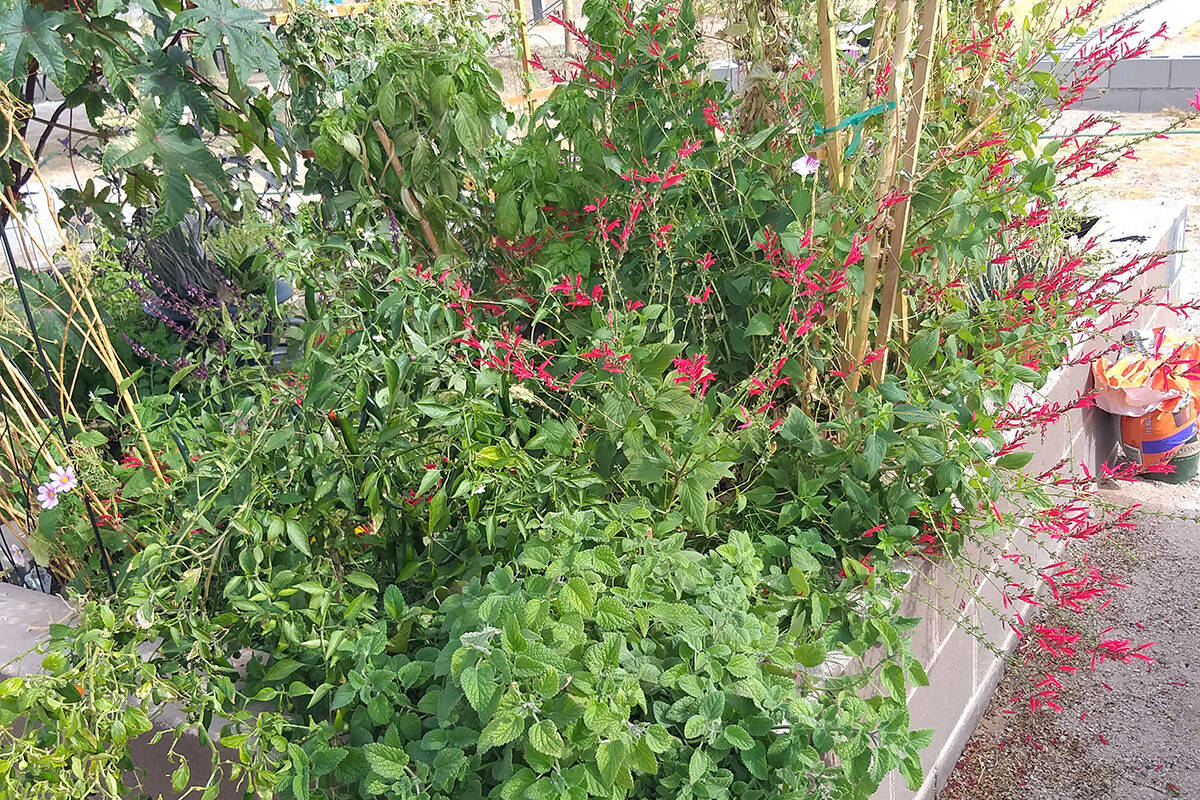Knowing when to plant in desert is crucial, horticulture expert says
When are the best times to plant in the desert?
UNLV Professor Bob Morris gives tips and tricks for gardening in the Southwest:
Q. We won’t move to Las Vegas until after June 1 and I am excited about using a raised bed. I’m guessing that’s too late to start a salsa garden, so what are my options? Wait till next spring? Attempt a winter garden? Try to start some plants and hope they don’t crisp when I transplant them come June? Any advice is super appreciated.
A. You are trying to “squeeze” in a fall crop of warm season vegetables from seed as well as plant your cool season varieties normally. Transplants are not available this time of year. I am not a big fan of transplants anyway so starting from seed can be a bit tricky in this hot and dry climate.
The soil is warm so that is not a problem. Keeping the seed swollen with water can be tricky. Use a light surface mulch. It helps during the summer. Planting seed during the heat requires that you visit your raised bed and check your seed (and new seedlings) at least twice a day; early morning and late afternoon. No need to keep the soil wet and soggy but the seed should be swollen with water.
You are gambling that the summer and warm fall will be long. June is not too late to plant fall, summer (warm season) and winter (cool season) crops. You can start fall tomatoes (such as ‘Early Girl’ and cherry tomatoes) as well as early peppers and eggplant around that time. You have two times for planting warm season crops; in the spring and again in mid- to late summer.
As you are moving in after June 1 it will be hot! Download a weather app for your phone and use it to help predict the future weather. Planting is best if there is a cooling spell but it is not necessary.
First, do soil preparation if needed. Then water deep a couple of times until the water comes out the bottom of the raised bed. Make sure the soil starts out moist before planting. Plant seed in the early morning hours. Cover the seed with a quarter inch of surface mulch immediately after watering. This can be straw, but I prefer horse or animal bedding. Use twice as many seeds as you need and remove unnecessary seedlings as they sprout to be on the safe side and keep your fingers crossed.
Very important to keep the seed swollen with water after you start watering! That keeps it alive. Water to keep the seed swollen (probably lightly twice a day when using mulch) and most warm season seed should be up in less than a week. Make sure the seed enters the heat of the day swollen with water so water in the morning hours.
Rely on seed bought from Territorial, Sakata, Park, Burpee, Baker Creek, Harris, Grow Organic, and other reliable seed companies. Rely on varieties that have done well here in the past. They will have what you need online. The vegetable seed available to you includes so-called warm season vegetables and cool season types. Buy both.
Q. I have a 20-year-old ash tree that was beautiful last summer. Now a good 40 percent of the tree looks dead. Last November a tree company cut down a nearby ash tree about five feet from the one we have now. They sprinkled a stump killer on the remaining stump. Near the poisoned tree stump are two Texas rangers: the furthest one is fine and one closer to the poisoned tree has deformed leaves and no flowers. The same for two lantana plants. Could this stump killer contaminate the ground or have gotten into the roots of our tree?
A. The picture you sent looks like ash decline, a common problem on several different types of ash trees and commonly seen on ornamental ash. There really isn’t anything you can do about ash decline except remove the tree. It’s a slow killer but kill it will. The best you can do is make sure your tree is getting enough water and the death is not caused by a lack of water and not ash decline.
Chemical damage to the remaining plants does sound like a possibility from your description. It is difficult to say which “stump killers” were used. Testing the soil near the trees could be very expensive. Without knowing what was used it is impossible to test the soil for it.
One group of chemicals would be “diluted” if a lot of extra water was used to flood the plants. Another group of chemicals that prevent resprouting are systemic and, once inside the plant, water won’t do much but won’t harm them. In other words, flood the trees close to their center or trunk, weekly and slowly with a hose or sprinkler, and see if the situation improves in about four weeks.
Q. I planted a little crepe myrtle about three weeks ago. It’s about 20 inches tall and came in a little 4-inch, 1-quart container. I amended the soil with lots of peat and covered it with wood chips. It looked fine for a week or so and now it’s turned brown. What do you think is going on with it? Am I overwatering it? Underwatering it?
A. My guess it was due to the planting location or how often it is watered or both. Crape myrtle, sometimes also called crepe myrtle, has a lot of variability, depending on which type you picked. The varieties range in height from “dwarf” forms at about 4 or 5 feet tall to standard sizes over 35 feet in height.
They are also variable in flower color. Some varieties are white flowered, some are pink, purple, red, and others again depending on the variety you selected. With these differences in height and flower color come also some differences in their tolerance to the heat and planting location.
There are lots of different choices when it comes to selecting crape myrtle for landscapes. Crepe myrtle was originally from northern India, the central part and north of China, and parts of Japan. It is a plant that prefers cooler landscape spots and “burn up” in hot landscape locations. Also watering daily (because you think it needs it) can also lead to its demise.
Don’t forget the planting season. The planting season should be starting in late January, February, March to the first parts of April. When hot weather begins special precautions need to be followed when planting or don’t plant again until cooler weather begins in the fall. Even very good gardeners have plant failures when planting during the heat of our summers.
When using surface mulch when planting, keep the wood mulch away from the trunk of trees by at least 6 inches after planting or it can get stem or trunk “rot” from having the soil constantly wet.
Q. I have had zero luck with apple trees planted on the east and north sides of my home. I think it might be the drainage of the soil. What can be done to improve soil drainage?
A. If water drains overnight (in about 8 hours) there should be no problem. Avoid watering all trees every day in the summer. Every other day or every third day so the roots can “breathe” is better. Give the soil a chance to drain. But if it takes much longer than that then I would do something about it.
One of the best solutions is to plant trees higher on a mound of soil. The mound is wider for larger plants. For apple trees I would suggest planting them about 12 inches higher than the surrounding soil. This gives the water a place to drain. Width of this mound is important as well. I suggest a mound that is three- to four-feet wide as well.
Try a technique called “vertical mulching.” This is augering holes in the soil about 18 inches from the tree in a square pattern around the trunk. These holes are about 18 to 24 inches deep and left open or filled with drain tiles to act as a “sump” for water drainage. You can also pack them with compost so that they drain and don’t collapse.
During cool weather plant inexpensive annual grass seed (annual ryegrass comes to mind) to improve the soil and keep the soil open. The roots of grasses (dead grasses included) are effective at improving a soil’s structure.
Bob Morris is a horticulture expert and professor emeritus of the University of Nevada, Las Vegas. Visit his blog at xtremehorticulture.blogspot.com. Send questions to Extremehort@aol.com.










